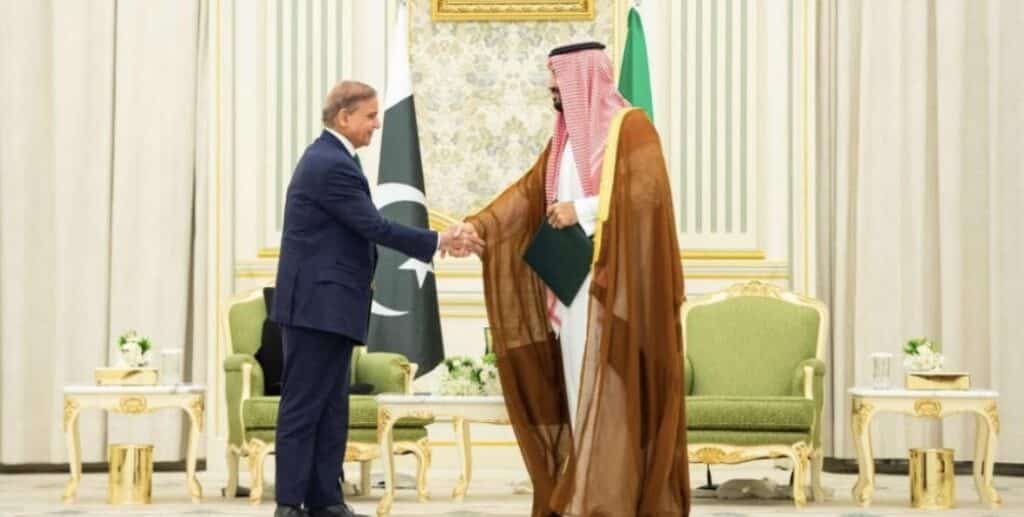
What is the Agreement
- On 17 September 2025, Pakistan and Saudi Arabia signed a Strategic Mutual Defense Agreement (SMDA) in Riyadh.
- It was signed by Pakistani Prime Minister Shehbaz Sharif and Saudi Crown Prince Mohammed bin Salman at Al Yamamah Palace.
- The key clause: “any aggression against either country shall be considered an aggression against both.”
Background & Context
To understand why the agreement came about, here are some relevant historical and geopolitical factors:
- 1. Long-standing Pakistan–Saudi relationship
- The two countries have had close ties since Pakistan’s foundation (Saudi Arabia was among first to recognize Pakistan in 1947).
- They had signed a Treaty of Friendship in 1951.
- Military cooperation has included training, deployment of Pakistani forces in Saudi Arabia (for training, advisory, technical assistance) over.
- 2. Recent regional security pressures
- Escalation of tensions in Middle East, especially following Israeli attacks in Qatar in early September 2025.
- Growing concerns among Gulf states about reliability of U.S. security guarantees.
- Saudi strategic diversification
- Saudi Arabia has been pursuing more autonomous defense relationships outside the U.S. framework.
Key Provisions / What Is Known vs What Is Unclear
Here’s what is known from public sources, and what remains ambiguous:
| What is Known | What is Unclear / Not Publicly Specified
|
| The mutual defense clause: aggression on one = aggression on both. | What counts as “aggression”—types of threats, geographic limits, what threshold triggers action.
|
| Agreement covers “all military means.” | Which military means, including conventional forces, air / missile defense, intelligence, joint operations, etc.
|
| Pakistani Defence Minister has said Pakistan’s nuclear program “will be made available” to Saudi Arabia under this defence pact.  | Exactly how the nuclear-sharing or nuclear deterrence part will be implemented, controlled, or bounded. Also, whether this is formal or more rhetorical / deterrence signalling.
|
| Both countries have emphasized this is defensive, not necessarily naming any specific adversary. | How “defensive” will translate into military mobilization, coordination, command & control, costs, legal obligations, etc.
|
Implications
The agreement has a number of significant implications, regionally, for international law, nuclear policy, and for third parties:
- Regional Security Balance
- The pact shifts the security dynamics in the Gulf and broader Middle East. Saudi Arabia obtaining such a mutual defense guarantee from Pakistan (which is a nuclear state) could act as a deterrent against threats Iran, Israel, or others might pose.
- Observers see this as possibly extending Pakistan’s nuclear umbrella to Saudi Arabia, or at least creating ambiguity which itself has deterrence value.
- Effect on U.S. Influence and Alliances
- This agreement may signal a lessening Saudi reliance on the U.S. for security guarantees.
- It potentially encourages defense autonomy and diversification of alliances in the Gulf.
- Proliferation and Nuclear Doctrine
- Offering “access” (or at least making nuclear deterrence available) to Saudi Arabia raises proliferation concerns. Scholars and analysts will want to know how this fits with international norms, IAEA safeguards, etc.
- Pakistan has historically maintained a doctrine of nuclear weapons being for deterrence, particularly vis-à-vis India. How this new agreement affects that doctrine is under scrutiny.
- Message to India and Others
- India is watching closely. The agreement may complicate its calculations with respect to the Gulf, Pakistan, and Saudi Arabia.
- Also, it might affect Saudi Arabia’s relations with India: maintaining balance may become more complex. 
- Potential for Broader Cooperation
- The SMDA appears to be part of a larger framework of cooperation: joint training, defense technology transfer, co‐production, possibly including intelligence sharing.
- There are suggestions that other Muslim or Gulf states—Qatar, UAE, etc.—could also become part of or benefit from similar arrangements.
Risks, Challenges, and Criticisms
While promising in certain ways for both countries, there are also risks and issues to consider:
- Ambiguity: The lack of detail in public sources means there is room for misinterpretation or disputes (e.g., what counts as an “aggression”, what actions are obligated).
- Escalation risks: Mutual defence pacts can raise the stakes in regional conflicts. If one partner is attacked or believes itself attacked, it may be compelled to respond, potentially drawing others in.
- Nuclear sharing implications: If indeed nuclear deterrence is extended to Saudi Arabia, that raises nonproliferation questions: whether this constitutes “nuclear sharing” under international law, the role of IAEA inspections, risk of technology leak, etc.
- Reaction from adversaries: Iran, Israel, or others could see this as threatening, and may adjust their posture accordingly. Could lead to an arms race or tighter alignments with other powers (e.g. U.S., China, Russia).
- Financial / operational burden: Defense pacts require resources: troop deployments, logistics, coordination, intelligence sharing, etc. Pakistan would need to ensure it has capacity. Saudi may need to invest in infrastructure, joint defense systems, etc.
- Domestic political risk: For both countries, entering such an agreement has internal implications—public opinion, constitutional limits, etc.—especially with nuclear obligations.
- International diplomatic risk: Other countries—especially those opposed to nuclear proliferation—might pressure via diplomatic means, and this could affect Pakistan’s relations with U.S., multilateral non-proliferation regimes, and Saudi Arabia’s regional reputation.
Open Questions
These are aspects that are not yet clear / should be monitored:
- 1. Operationalization: How will the agreement be put into practice? Joint military exercises? Stationing troops? Sharing command & control? Intelligence? Missile defense?
- 2. Nuclear “umbrella” details: Precisely what is meant by Pakistan making its nuclear deterrent “available”? Is this rhetorical, or legal / binding? Under what constraints?
- Scope of “aggression”: Who defines aggression, what thresholds, whether pre-emptive self-defence is included, etc.
- Involvement of other states: Will Pakistan and Saudi Arabia seek to bring in other Gulf or Muslim-majority states under this framework?
- Responses of key players: How will the U.S., Iran, Israel, India respond? Will this spur counter-alliances?
- Impact on nuclear nonproliferation regimes: Will this challenge existing norms, potentially prompting calls for new oversight?
Strategic Takeaways
- The SMDA signals a deepening of Pakistan-Saudi strategic alignment beyond purely religious & economic cooperation, moving into formalised defense mutuality.
- Saudi Arabia is clearly seeking more security assurance via regional partnership, possibly to reduce dependence on external (particularly U.S.) guarantees.
- For Pakistan, in addition to security benefit, this pact can strengthen diplomatic leverage, financial/riches from strategic cooperation, and its profile as a regional security actor.
- The pact could reshape security dynamics in South Asia & the Middle East, particularly with Israel’s operations, Iran’s posture, India’s interests, and U.S. role in the region

